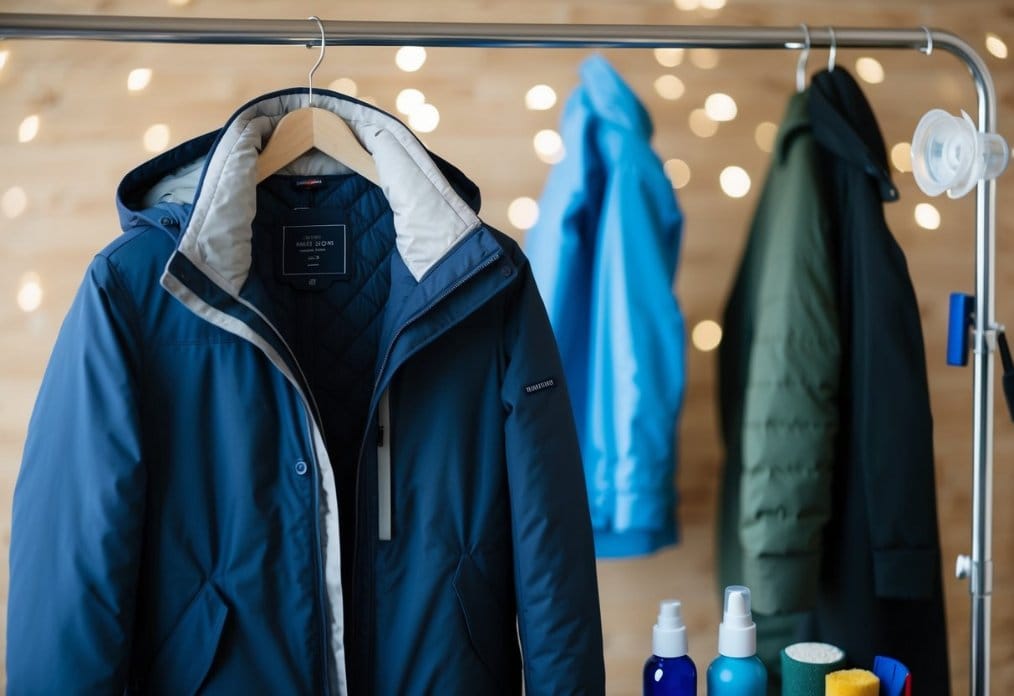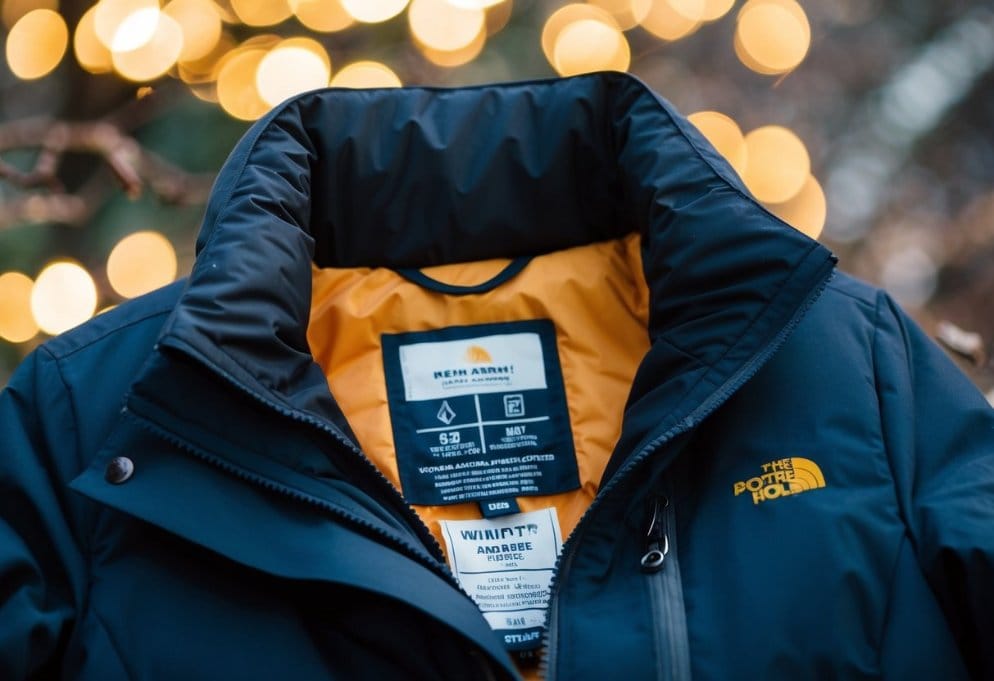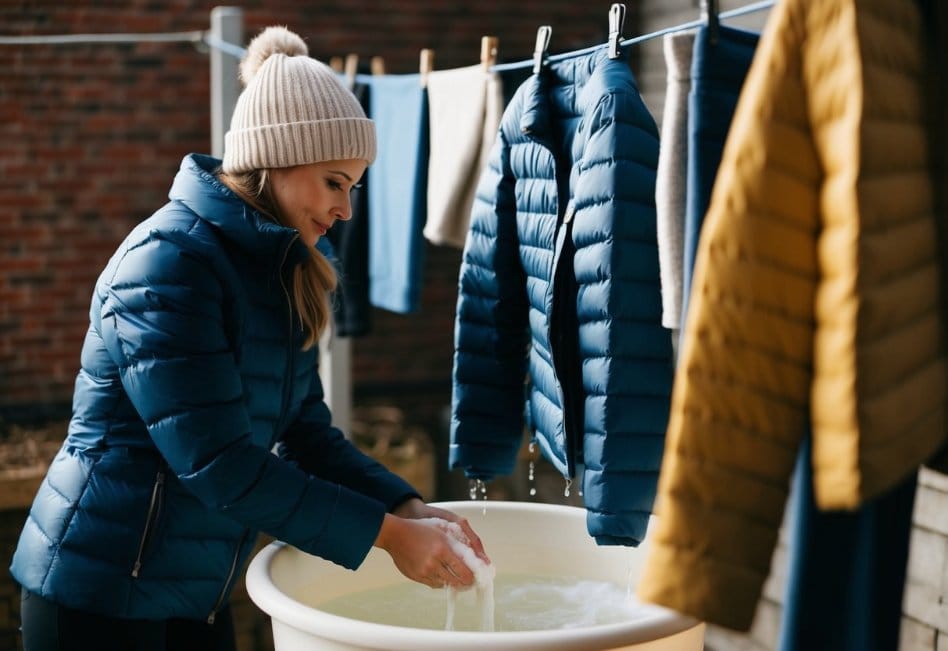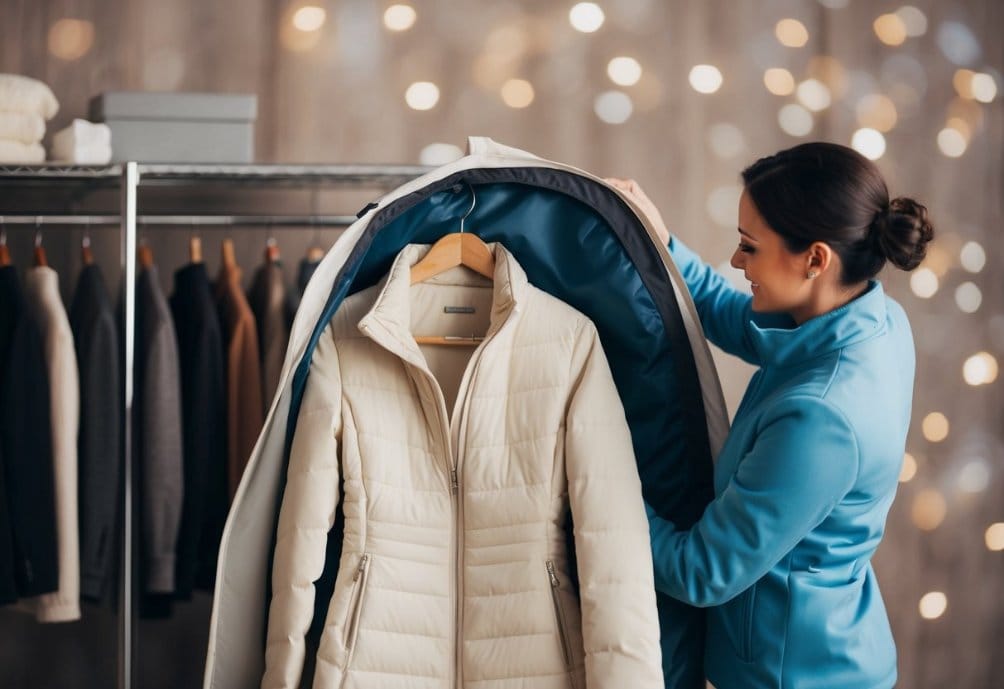Winter jackets are a must-have for cold weather, but they need proper care to stay warm and stylish. I’ve learned that taking good care of your winter coat can make it last for many seasons. Regular cleaning and proper storage are key to keeping your winter jacket in top shape.
Different materials need different care. I always check the care label before cleaning any jacket. Some coats can go in the washing machine, while others need dry cleaning. For wool coats, I use a soft brush to remove dirt and spot-clean stains. Puffer jackets often do well in the washer on a gentle cycle with cold water.
After cleaning, it’s important to dry your jacket the right way. I hang most coats to air dry, away from direct heat. For puffy coats, I toss in a few dryer balls to help fluff them up. When it’s time to store your jacket for the off-season, I make sure it’s clean and completely dry first. Then I keep it in a cool, dry place to prevent damage.
Table of Contents
Key Takeaways
- Check care labels and clean jackets according to their specific material needs
- Dry winter coats properly to maintain their shape and insulation
- Store clean, dry jackets in a cool place during off-seasons to prevent damage
Understanding Your Winter Jacket’s Materials

Winter jackets come in different materials, each with unique properties. Knowing your coat’s fabric helps you care for it properly and keep it looking great for years.
Wool and Fleece Coats
Wool coats are warm and classy. I love how they resist wrinkles and dirt. To clean a wool coat, I brush it gently to remove loose dirt. For stains, I dab them with a damp cloth and mild soap. Dry cleaning is best for deep cleaning.
Fleece coats are cozy and easy to care for. I wash mine in cold water on a gentle cycle. I use a mild detergent and avoid fabric softeners. To dry, I lay it flat or hang it up. Fleece can pill, so I use a fabric shaver to keep it smooth.
Both wool and fleece need to be stored properly. I hang them on padded hangers in a cool, dry place. This keeps their shape and prevents moths.
Down Coats and Puffer Vests
Down coats and puffer vests are super warm. They’re filled with down feathers or synthetic materials. I wash mine in a front-loading machine with a gentle detergent. I use the delicate cycle and cold water.
Drying is crucial for down. I put mine in the dryer on low heat with a few clean tennis balls. This fluffs up the down and prevents clumping. I make sure it’s completely dry to avoid mildew.
For storage, I keep my down coats in a breathable garment bag. I don’t compress them, as this can damage the fill. A cool, dry closet is ideal.
Parkas and Performance Outerwear
Parkas and performance outerwear are built to handle tough weather. They often have special coatings to repel water and wind. I clean mine based on the care label. Some can be machine washed, while others need special care.
To maintain the water-resistant coating, I use a spray-on waterproofing treatment every few washes. This keeps the jacket working like new. For daily care, I wipe off dirt with a damp cloth.
I store these jackets hanging up, away from direct sunlight. This prevents damage to the special coatings. If the jacket has a removable lining, I clean it separately.
Reading and Interpreting Care Labels

I always check the care label on my winter jackets before washing them. These tags have symbols that tell me how to properly clean and maintain the garment.
The washtub symbol shows washing instructions. A hand in the tub means hand wash only. Dots inside indicate water temperature – more dots mean hotter water.
For drying, I look for a square symbol. Lines inside tell me if I can tumble dry. An X means no tumble drying allowed.
The iron symbol is easy to spot. Dots show the heat setting. One dot is low, three dots is high. Some jackets can’t be ironed at all.
I pay attention to the circle symbol for dry cleaning info. An X through it means no dry cleaning. Letters inside give specific instructions for the cleaner.
Triangles refer to bleaching. A blank triangle allows bleach, while lines or an X prohibit it.
By carefully reading these symbols, I can keep my winter jackets in great condition for years to come. It only takes a minute, but makes a big difference in the long run.
The Right Way to Wash

Washing winter jackets properly keeps them clean and extends their life. I’ll cover key techniques for both hand and machine washing to help you care for your coat.
Hand-Washing Techniques
I start by filling a sink with cool water and adding a small amount of gentle detergent. Then I submerge the jacket and gently squeeze the soapy water through it. I avoid twisting or wringing, which can damage the fabric.
For tough stains, I use a soft brush to lightly scrub. After washing, I rinse thoroughly with cool water until all soap is gone.
To dry, I squeeze out excess water without twisting. Then I lay the jacket flat on a towel and reshape it. Air drying away from direct heat works best.
Machine-Washing Tips
I always check the care label first. Most winter jackets do best in cold water on a gentle cycle. I use a mild detergent and avoid fabric softeners.
To protect the jacket, I zip it up and turn it inside out before washing. I also put it in a mesh laundry bag if I have one.
I don’t overload the washer – the jacket needs room to move. After the cycle, I take it out promptly to avoid wrinkles. I reshape it gently and lay it flat or hang it to air dry.
Drying and Eliminating Odors Effectively

Proper drying and odor removal are key to keeping winter jackets fresh. I’ll share some tips for air-drying, using the dryer, and steaming to eliminate odors.
Air-Drying vs. Dryer
I always check the care label first. For down jackets, I air-dry them flat or hang them up. This keeps the feathers from clumping. Wool coats do best when laid flat to dry. They can lose shape if hung wet.
For machine-washable jackets, I use the dryer on low heat. I take them out while slightly damp to prevent shrinking. Synthetic jackets dry fast in the machine.
I never put leather or fur in the dryer. These need to air-dry away from direct heat and sunlight.
Using Dryer Balls and Steaming for Freshness
Dryer balls are great for fluffing jackets. I toss 3-4 in with my coat. They help remove wrinkles and speed up drying. For down coats, they keep the filling evenly spread.
Steaming is my go-to for odor removal. I hang the jacket and run a steamer over it. The hot steam kills odor-causing bacteria. It also removes wrinkles without damaging the fabric.
For stubborn smells, I spritz the jacket with a mix of water and white vinegar before steaming. This helps neutralize odors naturally.
Professional Care and Storage Solutions

Professional cleaning and proper storage are key to keeping winter jackets in top shape. I’ll cover when to get expert help and the best ways to store coats.
When to Opt for Professional Cleaning
I recommend professional cleaning for winter jackets once a season or when they get very dirty. Dry cleaning is best for wool coats and jackets with delicate trims. It removes tough stains and odors without damaging the fabric. For down jackets, I suggest finding a cleaner who specializes in these. They use special techniques to clean and refluff the down filling.
Some signs it’s time for pro cleaning:
- Visible stains that won’t come out at home
- Bad smells that linger
- Dull or matted fabric
- Yellowing on white or light-colored coats
Best Practices for Storage
I always clean jackets before storing them for the off-season. This prevents stains from setting and keeps bugs away. Wooden hangers are ideal for storage. They help coats keep their shape and allow air flow.
For long-term storage, I use garment bags or plastic bins. These protect from dust and pests. I avoid vacuum bags for down jackets as they can crush the filling. Cool, dry spots like closets or under-bed storage work well.
Tips for storing winter jackets:
- Use cedar blocks to deter moths
- Don’t cram coats together tightly
- Check on stored items every few months
- Avoid damp basements or hot attics

